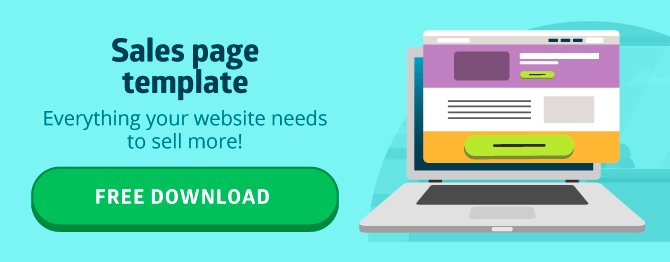
Guide: How to create a killer Landing Page
One of the things that might be preventing you to make a lot of sales is the lack of a Landing Page for your digital business. Read on and find out how to create one!

What will we see in this post
So, you have already created your digital product, you have your own website that gets good hits, but, nevertheless, you aren’t making a lot of sales.
This is a very common situation and it doesn’t necessarily mean that you’ve got a bad product nor that your newsletter is not interesting.
It’s possible that the reader just doesn’t know what to do when she gets to your website and also doesn’t want to search for any action.
Then what? She closes the page and starts her search again. If you are in this situation, don’t panic. Today you will learn about one of the most useful and important tools for online businesses: the Landing Page.
What is a Landing Page, anyway?
A very common mistake for people who are just starting out is to mix up the home page of the website with the Landing Page since both are there to receive the visitor. In fact, the two have very different jobs and this influences the way they should be understood and created.
The objective of your home page is to get the user and direct her easily to a number of places by which she may take an interest. It can be your file, your news link or your contact page, for example.
The home page works as a starting point for the visitor to explore what your page has to offer.
Whereas when the customer gets to your Landing Page, your goal is to get her to perform a specific action. It can be making a purchase, subscribing to a newsletter, signing a petition or even leaving their email address.
The only job of a Landing Page is to get the user to it, and all its features are designed around this goal.
The relationship between visitors to your landing page and the number of times they performed the action that you suggested there is called conversion rate. For example: If your Landing Page got 2,000 visitors and 500 of these visitors made the purchase you’ve proposed there, your conversion rate is 25%.
What does your Landing Page need?
Call to Action: This is another fundamental concept. The CTA, or Call to Action, is the link, button, image or text that calls your user to do something.
This button gives the order, the command for the reader to perform the action you want on the page.
Your Call to Action should be seen and understood in 5 seconds at the most! It must be obvious, uncomplicated and should appear more than once on the page.
If your user decides to read your page until the end and then decides to make the purchase, she shouldn’t need to go back to the top of the page just to click the button. There must be a button at the end waiting for her.
This is all to make the process as easy and intuitive as possible for your potential customer.
Value Proposition: Read your page very carefully, because it clearly shows what the value of your product or service is.
- What will it improve in your life?
- What problem will be solved?
- What will she learn?
It is important to clearly understand what benefits she will get by becoming your customer or subscriber. If you do not communicate your value clearly, the user is unmotivated and you won’t make the conversion.
Invite to learn more: You must provide an easy solution for someone who is interested in what you have to offer, so that she can get more information about your products and services.
Your Landing Page will provide the most important data and the most consulted information, but if that’s not enough, getting details, or even getting in touch with you to ask questions directly can’t be a problem.
Perhaps the client has taken an interest in your product, but she doesn’t know enough about the company, for example. Having a link so that she knows it better will bring her closer to the conversion stage.
If she has to resort to research to obtain this information, she will have more time to give up on that.
Social proof: How do you convince someone you barely know that your product is good? A great way of doing that is by using testimonials from people who already know you.
These can be from satisfied customers, positive reviews or news articles about your work. If you can show that other people who have done business with you were satisfied, you’re a step closer to convincing your potential customer to do the same.
Other people’s approval helps to validate what you say about yourself and about your digital product.
Create urgency: On your Landing Page “now” is the only time that matters.
It’s not your Landing Page’s job to make your audience add your product to a wish list for future purchases. There you want the customer to do the action at that moment.
Good strategies to do this are offering limited time rewards, promotions, and benefits. The consumer must feel that buying your digital product is a good idea but it is an even better idea to buy it right away.
Objections: It is likely that, when accessing your page, the reader puts herself on the defensive.
When you offer the solution to a problem, some people will think “but that’s not for my problem”. When you talk about an activity, they’ll say “I don’t have time”. And when you show the price, “but I have no money”.
These reactions are kind of automatic and completely natural. You do the same when you are looking for a product. You question yourself and wonder if that really is for you.
It is inevitable, but don’t panic. There is a way to go around this initial resistance.
So, you should put yourself in your customer’s shoes and imagine: “What objections will my product drive in my audience?”
You will then handle these objections on your Landing Page, by explaining how your product or service is suitable to them and will serve them very well. Thus, you eliminate the objection before it is even manifested, reassuring the customer and making her more prone to make the purchase.
Converting hits into sales
By now you’ve already put all the items discussed here on your Landing Page but your conversion rate is still low. What might be the problem? Let’s see some of the most common problems:
Relevance: Your Landing Page should only contain highly relevant information to the buying process. Additional information should be easily available but through a link.
Make sure that every photo, text, and button serve the purpose of the Landing Page. Whatever isn’t necessary only confuses and distracts the user and should be avoided.
Quality: Is your text well-written and free from English mistakes? Are your images beautiful, well-produced and without any compression issues? Does your page load quickly and without errors?
A bad presentation gives the impression that the product is also bad. A spotless Landing Page adds value to your product and improves your chances of making a sale.
Location: By looking at your Landing Page, will a user be able to find everything she wants on her first visit?
Prevent the visitor from resorting to the search field. Group the elements by similarity and usefulness.
If there is a text with a Call to Action for purchase, the buy button must be close by. The checkout button should be close to the “view shopping cart.”
If you ask the user to give you her email, there must be a field ready to get the address right away. Someone may be interested in signing your newsletter after reading your presentation but if she doesn’t find the button to sign up for it fast enough, she will probably leave.
Highlights: What are the elements that dominate your page? Do they work to get to the conversion? Your space is limited and must be used in the best way possible.
What is more helpful to sell your product? Is it an image? A statement given by a public figure? Make this element more visible than the others. Place it at the top of the page, or use a larger size/font.
Everything that relates more to the Call to Action must be easily seen, more than the elements that are only there for support.
Always improve
As we have seen, coming up with a Landing Page isn’t exactly a cake recipe.
There is no one format or unique combination that will suit well all digital products. You must pay close attention to your audience, understand what they expect and their likes to create your ideal Landing Page.
You should always measure your conversion rate, observe if it is moving up or down and maintain the habit of making adjustments on the page whenever necessary, always having in mind what you’ve learned today.
You will find out what works best for you and your audience and you will be able to maximize your sales.
If that all sounded a little too dense and complicated, don’t panic.
It is simpler than it looks. It just demands attention, effort and work to set up, monitor and improve your Landing Page, always. The return is worth it!
Is making sales the main objective of your landing page? Find out everything a sales page needs to sell more!





